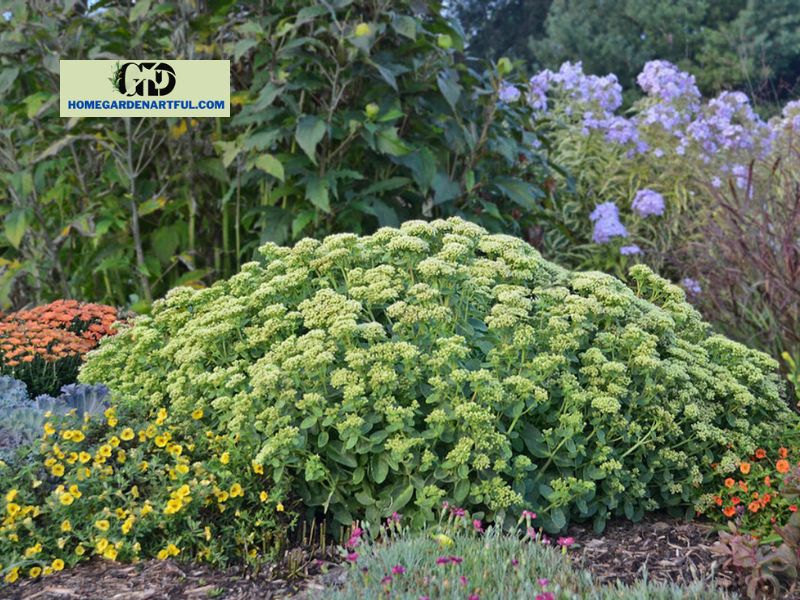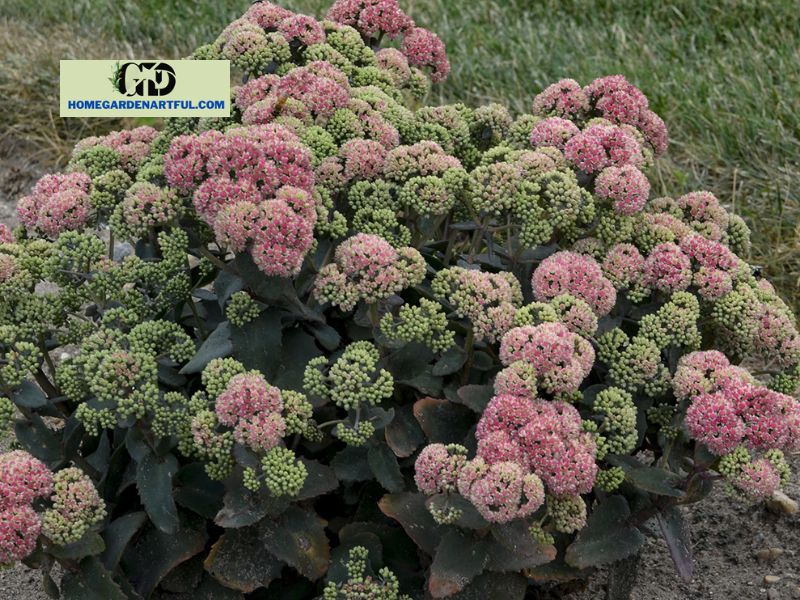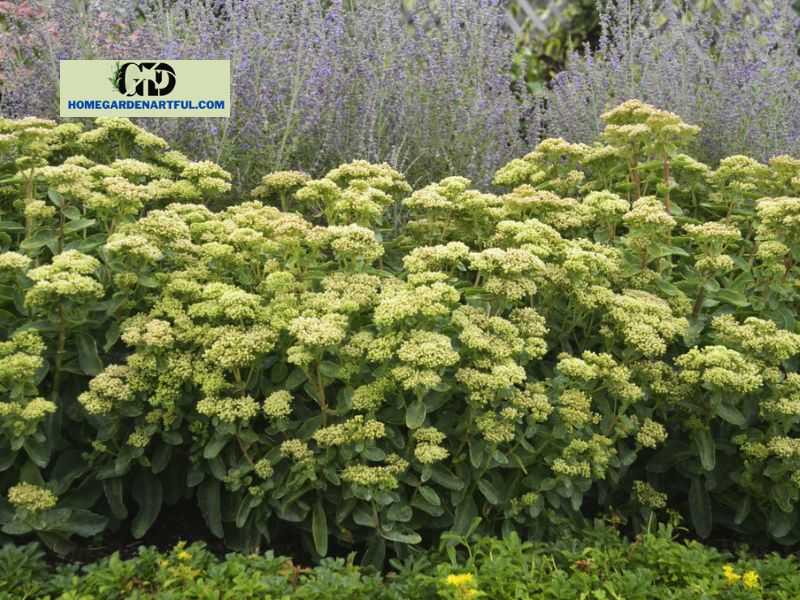Sedum Lemonjade is the result of an open-pollinated batch of seeds gathered on November 5, 2008, with ‘Sheila McQueen’ as the female or pod parent and an unknown pollen parent. Asexual reproduction by vegetative cuttings has demonstrated that the plant’s distinctive characteristics are durable and reproduce true to type in subsequent generations.
It is an evergreen perennial herb that grows to be 40 cm tall by 54 cm wide and has a compact, clump-forming, mounded plant habit. The stems are 20 cm long, glaucous, and green. The leaves are oval, smooth, glabrous, glaucous, fleshy, with a rounded base, bluntly sharp apex, irregularly and shallowly dentate border, pinnate venation, and blue-green in color.
Lemonjade Stonecrop blooms from summer to autumn, with terminal compound cymes inflorescences up to 20 cm long with 10,000 flowers and buds per plant. The blooms are pale yellow, sweetly fragrant, and have white buds. They are borne on a 20 cm long, light blue-green peduncle that is glaucous, glabrous, robust, and stiff. Discover at homegardenartful.com!
Care for Sedum Lemonjade

Cultural information is meant to serve as a guide and should be tailored to your own needs. Your physical location; where you’ll grow your plants, how much time you have to commit to their maintenance, and a variety of other aspects must all be considered. Only then can you determine which cultural practices are ideal for you and your plants.
Light and exposure
Sedum Lemonjade tolerates some shade (but not complete shadow), but thrives in full sun. In most circumstances, the higher the better, with a minimum of 50000 lux. High light is required for the plant to generate significant leaf coloring and low light circumstances cause the plant to stretch. Low light levels can be compensated for by dry soil conditions, but only for a limited duration.
Temperature
Lemonjade Stonecrop can be grown in USDA zones 4-9. The plant enjoys night temperatures above 13 °C and day temperatures between 18 and 21 °C. However, the scorching summer days will not be an issue, as temperatures as high as 38 °C can still produce high-quality plants. Keep an eye out for disease outbreaks caused by high heat and humidity.
The plant can withstand cold temperatures. When the temperature falls below 10 °C, the plant goes dormant. If you experiment with plants that are borderline resistant to freezing temperatures, and if you live in a region where the temperature routinely drops below freezing, try growing them in pots so you can transfer them indoors for shelter from the cold.
Substrate and grow media

Sedum Lemonjade can be grown in a pot, container, or in the garden with loose sandy, loamy, or gravelly soil that drains well. Unglazed clay or terra cotta pots dry faster than glazed pottery or plastic pots. When the soil absorbs too much water, as frequently the case with thick wet clay soil, the plant can easily develop root rot.
Plants in containers demand slightly more attention than those in gardens. When your plants outgrow their present pot, repot them by shifting them to a larger container that can hold the plant better. Repotting is best done in the spring.
Watering
Lemonjade Stonecrop is drought-tolerant, but it does require some water. They thrive with frequent irrigation from spring to fall. Water thoroughly, then allow the soil to dry before watering again. For the first several weeks, young plants will require additional water to grow roots. Established plants should not require any further watering as long as your area receives rain every couple of weeks at the very least. When watering, avoid getting the stems, leaves, and flowers wet. In the winter, only water is enough to keep your plants from shriveling.
Fertilizer
Sedum Lemonjade does not require supplementary fertilizing and can grow in nutrient-deficient soil. In fact, overly rich soil might result in poor, lanky growth. If you have very poor soil, adding in some compost will usually suffice to give your plant a boost. Stretching and flopping can be caused by chemical fertilizer.
Winter
Avoid overwatering and overfertilizing any of these plants, especially during the shorter days, reduced light levels, and cooler temperatures of winter.
Covering the plants with straw or constructing a tent made of plastic or bed sheets over them will protect them from sudden freezing temperatures; however, plastic should not come into contact with the plants. As soon as the temperature rises, remove any covering.
Pruning
Lemonjade Stonecrop does not require deadheading (removing wasted blooms) and can look nice throughout winter. Extreme heat and a lack of sunlight, on the other hand, can lead the plants to become leggy. After the flowers have faded, prune the plants to keep their shape and stimulate bushier, sturdier growth.
Pests and diseases

If the plant is overwatered or overcrowded, it may become infested with scale insects and/or mealybugs. Slugs and snails can also be a nuisance outside. Overwatering, overcrowding, and a lack of sufficient air circulation can all cause root and stem rot in succulents. To avoid these issues, give your plants plenty of room to develop and spread. To control mealybugs and scale insects indoors, use an appropriate pesticide. Encourage natural predators such as ladybugs as well as lacewings outside. Slugs and snails must be removed by hand. Plants should be thinned to decrease hiding spots and promote air circulation. Crushed eggshells as well as diatomaceous earth sprinkled around afflicted plants may deter these gastropods.
Propagation
Sedum Lemonjade is relatively easy to grow through stem cuttings or division. Take stem cuttings in the spring while the plants are actively growing; simply snip off a part of the stem from a healthy plant that’s 3 to 6 inches long, as well as remove the leaves on the lower half. Then, plant the cut end wherever you choose. Even if these prolific stems are merely resting on top of soil, they will send out roots, but planting them will give them a higher chance of healthy growth.
Each leaf has the ability to grow into a new plant. Select healthy leaves, remove them from the plant, and let them callus for a few days. Place the leaves in a well-draining soil mix that is kept slightly damp. After around 2 to 3 weeks, they should be well rooted, with new plantlets growing at the base.
Gently dig up a mature plant and carefully take apart the roots to separate it into portions to propagate through division. Simply transplant the parts, making sure the root ball’s top is level with the soil line. Divided pieces, like stem cuttings, will often take root quickly.


